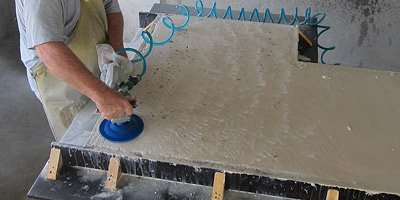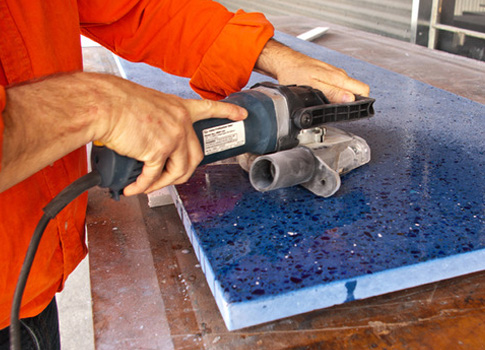Polished concrete countertops have become a popular choice for homeowners and designers seeking a modern, industrial look with durability and functionality. Creating polished concrete countertops is a multi-step process that requires careful planning, preparation, and execution. Here’s a comprehensive guide on how to make polished concrete countertops:
Planning and Design: Begin by planning the layout and design of your concrete countertops, including dimensions, thickness, and any additional features such as integrated sinks or decorative edges. Consider the overall aesthetic of your kitchen or bathroom to ensure the countertops complement the existing decor.
Gathering Materials: To make polished concrete countertops, you’ll need materials such as concrete mix, reinforcement fibers or mesh, concrete sealer, diamond polishing pads, and optional additives like colorants or decorative aggregates. Gather all necessary materials and tools before starting the project.
Formwork Construction: Construct formwork or molds to create the shape and size of your countertops. Formwork can be made from various materials such as melamine, wood, or plastic, depending on your design preferences. Ensure the formwork is sturdy and well-supported to prevent leakage or shifting during pouring.
Reinforcement Placement: Before pouring the concrete mix, place reinforcement fibers or mesh within the formwork to add strength and prevent cracking. Reinforcement helps ensure the durability and longevity of the finished countertops, especially in high-traffic areas like kitchens.

Mixing and Pouring: Mix the concrete according to manufacturer instructions, adding any colorants or decorative aggregates as desired. Pour the concrete mix into the formwork, ensuring even distribution and smoothing the surface with a trowel. Vibrating the formwork can help remove air bubbles and ensure a smooth finish.
Curing and Drying: Allow the concrete to cure and dry completely according to manufacturer recommendations, typically for at least 24 to 48 hours. Proper curing is essential for achieving strong and durable countertops that resist cracking and chipping over time.
Demolding and Sanding: Once the concrete has cured, carefully remove the formwork to reveal the rough countertops. Use a sander or diamond grinding pads to smooth the surface and remove any imperfections or rough edges. Start with a coarse grit and gradually work your way up to finer grits for a smooth finish.

Sealing the Surface: After sanding, apply multiple coats of concrete sealer to the countertops to protect the surface from stains, water damage, and wear. Choose a high-quality concrete sealer suitable for countertops and follow the manufacturer’s instructions for application.
Polishing Process: Once the sealer has dried, begin the polishing process using diamond polishing pads. Start with a low-grit pad and gradually increase the grit to achieve the desired level of shine and smoothness. Use a wet polishing process, keeping the surface wet to prevent overheating and ensure a uniform finish.
Final Finishing: After polishing, inspect the countertops for any remaining imperfections or uneven areas. Touch up any areas as needed with finer grit polishing pads to achieve a uniform and glossy finish. Wipe down the countertops to remove any dust or residue from the polishing process.
Applying a Final Sealant: Once the countertops are polished to your satisfaction, apply a final coat of concrete sealer to protect the surface and enhance the shine. Choose a sealer specifically formulated for polished concrete countertops and follow the manufacturer’s instructions for application.
Curing and Drying: Allow the final coat of sealer to cure and dry completely before using the countertops. This typically takes several days, during which time it’s essential to avoid placing heavy objects or applying excessive pressure on the countertops to prevent damage to the finish.
 Regular Maintenance:
Regular Maintenance: To keep your polished concrete countertops looking their best, clean them regularly with a mild detergent and water, avoiding harsh chemicals or abrasive cleaners that can damage the sealer. Wipe up spills promptly to prevent staining, and reapply sealer as needed to maintain protection.
Preventing Damage: While polished concrete countertops are durable, they can still be prone to scratching or chipping if not properly cared for. Use cutting boards and trivets under hot cookware to protect the surface from damage, and avoid dropping heavy objects that could cause cracks or chips.
Enjoying Your New Countertops: Once your polished concrete countertops are installed and properly maintained, enjoy the sleek, modern look they bring to your kitchen or bathroom. With proper care and maintenance, polished concrete countertops can provide years of durable and stylish functionality.
 How long does it take to make polished concrete countertops?
How long does it take to make polished concrete countertops?
The process of making polished concrete countertops can take several days to complete, including planning, mixing, pouring, curing, sanding, sealing, and polishing. Proper curing and drying times are essential for achieving durable and long-lasting countertops.
Can I customize the color and design of polished concrete countertops?
Yes, polished concrete countertops can be customized with various colorants, decorative aggregates, or surface treatments to achieve the desired look and style. From bold colors to natural stone-like patterns, the design possibilities are virtually endless.
Are polished concrete countertops durable?
Yes, properly made and sealed polished concrete countertops are highly durable and resistant to stains, scratches, and heat. With proper care and maintenance, polished concrete countertops can provide years of functional and aesthetic appeal in kitchens and bathrooms.
How do I maintain polished concrete countertops?
To maintain polished concrete countertops, clean them regularly with mild detergent and water, avoiding harsh chemicals or abrasive cleaners that can damage the sealer. Wipe up spills promptly to prevent staining, and reapply the sealer as needed to maintain protection.
Can I install polished concrete countertops myself?
While DIY installation of polished concrete countertops is possible for experienced homeowners with proper tools and knowledge, it’s essential to follow the correct procedures for mixing, pouring, curing, sanding, sealing, and polishing to achieve professional results. Consider consulting with professionals or attending workshops for guidance before undertaking a DIY project.
DIY Concrete Countertops For DUMMIES

Concrete Countertops – Pros, Cons, DIY u0026 Care – Concrete Network

Finishing Concrete Countertops – How To Polish A Concrete Countertop

The Three Stages of Grinding and Polishing Concrete Countertops

how-to-polish-concrete-countertop-485×350 Concrete Exchange

Concrete Countertop DIY – A Beautiful Mess

Related articles:


 Regular Maintenance: To keep your polished concrete countertops looking their best, clean them regularly with a mild detergent and water, avoiding harsh chemicals or abrasive cleaners that can damage the sealer. Wipe up spills promptly to prevent staining, and reapply sealer as needed to maintain protection.
Preventing Damage: While polished concrete countertops are durable, they can still be prone to scratching or chipping if not properly cared for. Use cutting boards and trivets under hot cookware to protect the surface from damage, and avoid dropping heavy objects that could cause cracks or chips.
Enjoying Your New Countertops: Once your polished concrete countertops are installed and properly maintained, enjoy the sleek, modern look they bring to your kitchen or bathroom. With proper care and maintenance, polished concrete countertops can provide years of durable and stylish functionality.
Regular Maintenance: To keep your polished concrete countertops looking their best, clean them regularly with a mild detergent and water, avoiding harsh chemicals or abrasive cleaners that can damage the sealer. Wipe up spills promptly to prevent staining, and reapply sealer as needed to maintain protection.
Preventing Damage: While polished concrete countertops are durable, they can still be prone to scratching or chipping if not properly cared for. Use cutting boards and trivets under hot cookware to protect the surface from damage, and avoid dropping heavy objects that could cause cracks or chips.
Enjoying Your New Countertops: Once your polished concrete countertops are installed and properly maintained, enjoy the sleek, modern look they bring to your kitchen or bathroom. With proper care and maintenance, polished concrete countertops can provide years of durable and stylish functionality.
 How long does it take to make polished concrete countertops?
The process of making polished concrete countertops can take several days to complete, including planning, mixing, pouring, curing, sanding, sealing, and polishing. Proper curing and drying times are essential for achieving durable and long-lasting countertops.
Can I customize the color and design of polished concrete countertops?
Yes, polished concrete countertops can be customized with various colorants, decorative aggregates, or surface treatments to achieve the desired look and style. From bold colors to natural stone-like patterns, the design possibilities are virtually endless.
Are polished concrete countertops durable?
Yes, properly made and sealed polished concrete countertops are highly durable and resistant to stains, scratches, and heat. With proper care and maintenance, polished concrete countertops can provide years of functional and aesthetic appeal in kitchens and bathrooms.
How do I maintain polished concrete countertops?
To maintain polished concrete countertops, clean them regularly with mild detergent and water, avoiding harsh chemicals or abrasive cleaners that can damage the sealer. Wipe up spills promptly to prevent staining, and reapply the sealer as needed to maintain protection.
Can I install polished concrete countertops myself?
While DIY installation of polished concrete countertops is possible for experienced homeowners with proper tools and knowledge, it’s essential to follow the correct procedures for mixing, pouring, curing, sanding, sealing, and polishing to achieve professional results. Consider consulting with professionals or attending workshops for guidance before undertaking a DIY project.
How long does it take to make polished concrete countertops?
The process of making polished concrete countertops can take several days to complete, including planning, mixing, pouring, curing, sanding, sealing, and polishing. Proper curing and drying times are essential for achieving durable and long-lasting countertops.
Can I customize the color and design of polished concrete countertops?
Yes, polished concrete countertops can be customized with various colorants, decorative aggregates, or surface treatments to achieve the desired look and style. From bold colors to natural stone-like patterns, the design possibilities are virtually endless.
Are polished concrete countertops durable?
Yes, properly made and sealed polished concrete countertops are highly durable and resistant to stains, scratches, and heat. With proper care and maintenance, polished concrete countertops can provide years of functional and aesthetic appeal in kitchens and bathrooms.
How do I maintain polished concrete countertops?
To maintain polished concrete countertops, clean them regularly with mild detergent and water, avoiding harsh chemicals or abrasive cleaners that can damage the sealer. Wipe up spills promptly to prevent staining, and reapply the sealer as needed to maintain protection.
Can I install polished concrete countertops myself?
While DIY installation of polished concrete countertops is possible for experienced homeowners with proper tools and knowledge, it’s essential to follow the correct procedures for mixing, pouring, curing, sanding, sealing, and polishing to achieve professional results. Consider consulting with professionals or attending workshops for guidance before undertaking a DIY project.




